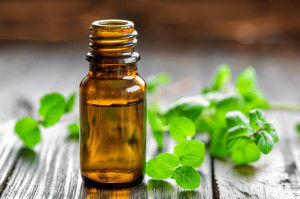
Peppermint (Mentha piperita) is a highly fragrant herb that is actually a hybrid cross between watermint and spearmint. For centuries, this herb has been held in high esteem due to its healing effects and aromatic properties.
An excellent source of manganese and vitamins A, B2 and C, as well as folate, iron, calcium and potassium, peppermint has high concentrations of carotenoids that link the herb very closely with colorectal cancer protection.
But, what is it that makes peppermint so incredibly powerful? Let’s take a look…
Secret weapon #1: menthol
One of the main active ingredients in peppermint is menthol, found in the plant’s leaves. Menthol has a long history of easing stomach woes and can be found in numerous commercial products such as toothpaste, pain cream, chewing gum, mouthwash and lozenges.
Menthol stimulates nerves that detect cold, and that is what brings the rush of coolness that can help relieve pain, ease a nagging cough and comfort a sore muscle.
Menthol has long been used to treat gas and bloating, and is a possible assistive remedy for irritable bowel syndrome, indigestion and colic, according to University of Michigan Health System.
The Journal of Gastroenterology and the British Journal of Clinical Practice both published studies showing that peppermint oil capsules containing menthol were an effective treatment for pain caused by intestinal spasms. Additional studies published in the Journal of Digestive and Liver Disease and Digestion found that herbal remedies containing menthol helped with indigestion.
Topical application of menthol can help relieve headaches, according to the University of Maryland Medical Center, and is also used to reduce itching and inflammation from hives and dermatitis.
Secret weapon #2: rosmarinic acid
In addition to menthol, peppermint leaves contain another powerful compound, rosmarinic acid. This substance acts as a free-radical blocking antioxidant that can block the production of inflammatory substances, such as leukotrienes, that restrict airways. In addition, it also encourages cells to produce prostacyclins that keep airways open for easy breathing. Peppermint extracts have also been used to relieve symptoms of colds related to allergies.
Additional benefits of peppermint
Animal studies of peppermint indicate that the powerful phytonutrient perillyl alcohol may help to stop the growth of pancreatic liver and mammary tumors. It has also been shown to protect against cancer formation in the lungs, skin and colon.
Peppermint essential oil has been found to inhibit the growth of a number of different types of bacteria, including Helicobacter pylori, Salmonella enteritidis and methicillin-resistant Staphylococcus aureus (MRSA).
 Using fresh peppermint
Using fresh peppermint
If you’re looking for a lower-calorie, sugar free way to incorporate peppermint into your diet, try making a peppermint tea or adding fresh peppermint leaves to ice cubes and then putting a few cubes into your water for a minty fresh drink.
Or just sprinkle fresh leaves over cold salads and chilled soups, to not only give you that minty fresh feeling but also to provide the benefits of this great plant. To store fresh mint leaves, carefully wrap them in a damp paper towel and place it inside a loosely closed plastic bag. Leaves will stay fresh for 3-5 days. Keep dried mint in a tightly sealed glass container in a cool and dark place. It will keep there for up to a year.
-The Alternative Daily

